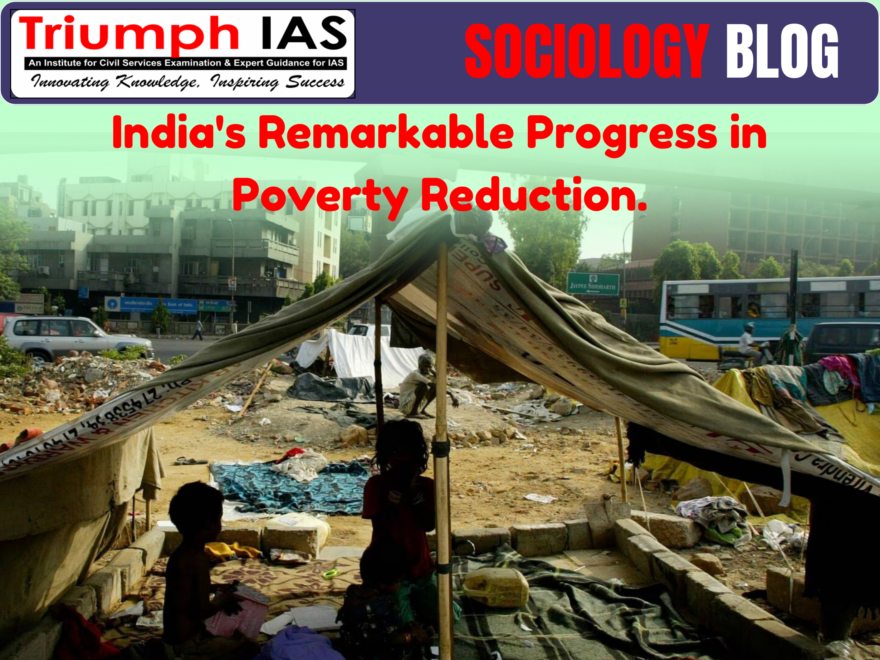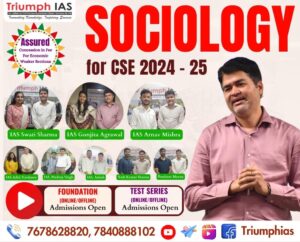India’s Remarkable Progress in Poverty Reduction.
Relevant for Sociology Optional for Civil Service Examination.
Sociology Paper -2
Unit 7 : Challenge of Social Transformation
India’s Remarkable Progress in Poverty Reduction.
Niti Aayog report
A NITI Aayog report reveals that in the last 9 years, 24.8 crore individuals have risen above the poverty line in India, marking a substantial improvement. Uttar Pradesh witnessed the most significant change, with 5.94 crore people benefiting, followed by Bihar, where 3.77 crore individuals experienced an uplift, along with 2.30 crore in Madhya Pradesh and 1.87 crore in Rajasthan.
According to the report, India’s poverty rate has declined from 29.17 percent in 2013-14 to 11.28 percent in 2022-23, reflecting a remarkable decrease of 17.89 percent over the past 9 years. The assessment of poverty alleviation considers factors such as enhanced education, healthcare, and lifestyle, encompassing aspects like child nutrition, mortality rates, maternal health, school education, attendance, cooking fuel, sanitation, drinking water, electricity, housing, property, and bank account.
The rate of poverty reduction has accelerated, with a 4 percent higher pace observed between 2015-16 and 2019-21 compared to the period from 2005-06 to 2015. The data reveals substantial improvements in all 12 indicators of the Multidimensional Poverty Index (MPI). Key initiatives like Poshan Abhiyaan and Anemia Mukt Bharat have played a pivotal role in enhancing access to healthcare facilities.
The report highlights the positive impact of five central government schemes:
- Pradhan Mantri Ujjwala Yojana, initiated on May 1, 2016, has benefited over 10 crore people by providing economically weaker families with free gas connections and financial assistance of Rs 1600.
- Pradhan Mantri Jan Dhan Yojana, launched on August 28, 2014, has achieved almost 100% coverage, with 51.42 crore account holders and Rs 2 lakh crores deposited.
- Pradhan Mantri Garib Kalyan Anna Yojana, introduced in 2020 and extended till 2029, offers free food grains to about 81.35 crore people, providing 5 kg of wheat or rice and one kilogram of whole gram monthly per family member.
- Pradhan Mantri Jan Arogya Yojana, with 30 crore Ayushman cards issued under the major health insurance scheme Ayushman Bharat Pradhan Mantri Jan Arogya Yojana, ensures free treatment up to Rs 5 lakh for citizens and commenced on September 25, 2018.
- Jal Jeevan Mission, launched on August 15, 2019, aims to provide tap water to every household in all villages by 2024, with connections already established for 14 crore houses and a total target of 19 crore houses.
UN and Oxford University Report
A recent report from the United Nations and Oxford University has highlighted India’s significant progress in reducing poverty. The report reveals that between 2005-06 and 2019-21, 41.5 crore people in India have moved above the poverty line. This information is based on the Global Multidimensional Poverty Index (MPI) released by the United Nations Development Program and Oxford University.
The report also indicates that in 2005-06, around 6.45 crore people in India were living in extreme poverty, a number that decreased to approximately 3.70 crore in 2015-16 and further dropped to 2.30 crore in 2019-21. This demonstrates a substantial reduction in poverty levels, particularly among India’s poorest states and groups, including children and individuals from backward castes.
Globally, out of 610 crore people across 110 countries, 110 crore people live in extreme poverty, with nearly half of them being children under 18 years of age (56.6 crore). The poverty rate among children is 27.7%, while among adults, it is 13.4%.
The report also highlights that poverty disproportionately affects people in rural areas, with 84% of the poor population residing in rural areas. It is noted that rural areas are generally poorer than urban areas. Furthermore, the report identifies 25 countries, including India, that have halved their global MPI values, indicating the potential for rapid progress within a 15-year timeframe.
Reference: Daiik Bahskar
Related Blogs…
Frequently Asked Questions:
1. Question: Define the term “ethnic movement” and provide an example from India.
Answer: An ethnic movement refers to a collective effort by a group sharing common cultural, linguistic, or religious traits, seeking to assert their identity and rights; an example from India is the Khalistan Movement in Punjab.
2. Question: Identify the main objectives behind the Gorkhaland ethnic movement.
Answer: The Gorkhaland ethnic movement primarily seeks to establish a separate state for India’s Nepali-speaking population in the Darjeeling region, advocating for linguistic and cultural recognition and political autonomy.
3. Question: What was the Operation Blue Star, and which ethnic movement was it related to?
Answer: Operation Blue Star was a military action in 1984, aiming to remove Sikh militants hiding in the Golden Temple in Amritsar; it is related to the Khalistan movement, which sought a separate Sikh country.
4. Question: Mention a critical factor that triggered the emergence of ethnic movements in India, as discussed by Dipankar Gupta.
Answer: Dipankar Gupta emphasized that ethnicity is fundamentally a political process, wherein caste and religion, the key components of identity formation, are politicized by leaders for vested interests.
5. Question: What were the primary reasons for the Assam Ethnicity conflicts involving Bodo tribals and Bengali Muslim settlers?
Answer: The Assam Ethnicity conflicts primarily stemmed from issues related to immigration, land rights, and resource allocation, leading to clashes, riots, and evolving relationships among indigenous communities to address challenges.
6. Question: Briefly describe the role of the Dravidian Movement in terms of caste and societal structure.
Answer: The Dravidian Movement, led notably by E.V. Ramasamy, aimed to establish an egalitarian society, focusing on anti-Brahmanism and advocating for equal rights for backward castes, while also introducing reforms like self-respect marriages.
7. Question: Name the prominent ethnic movements in North-East India and specify one common objective.
Answer: Prominent ethnic movements in North-East India include the Nagas’ and Mizos’ struggles; a common objective was to gain autonomy and recognition for their distinct tribal identities and cultural uniqueness.
8. Question: What is the key argument of Gail Omveldt regarding traditional Indian society and multiculturalism?
Answer: Gail Omveldt opposed romanticizing traditional Indian society, arguing that hierarchy has always dominated it and dismissing the notion that multiculturalism is an intrinsic feature of Indian society as a myth.
9. Question: Briefly explain the social hierarchy factor as a contributing element to ethnic movements as suggested by Olzak.
Answer: Olzak suggests that the construction of hierarchies among ethnic communities, which often leads to the suppression of one group by another, is a key factor that can instigate social and ethnic movements.
10. Question: Identify one consequence of the unequal economic development factor within the context of ethnic movements in India.
Answer: One consequence of unequal economic development is the marginalization and underdevelopment of certain groups, leading to feelings of alienation and sometimes initiating ethnic movements as these groups strive for equality and recognition.
GS Related Practices Questions…
To master these intricacies and fare well in the Sociology Optional Syllabus, aspiring sociologists might benefit from guidance by the Best Sociology Optional Teacher and participation in the Best Sociology Optional Coaching. These avenues provide comprehensive assistance, ensuring a solid understanding of sociology’s diverse methodologies and techniques.
META TAGS:
Ethnic Movements, ethnic movements in india, ethnic movement in sociology, Punjab Movement, North-East Ethnic Movements, Gorkhaland Movement, Dravidian Movement, Assam Ethnicity, Ethnic Conflicts, Sociopolitical Impact, India, Ethnic Consciousness, Ethnic Rights, Political Crisis, Economic Development, Cultural Disparities, Khalistan Movement, Nagaland, Mizoram, Multiculturalism, Political Economy, Identity Formation, Social Hierarchies, Bodo Tribals, Bengali Muslim Settlers, Anti-Sikh Riots, Operation Blue Star, Unequal Development, Ethnic Violence, Political Mobilization
Why Vikash Ranjan’s Classes for Sociology?
Proper guidance and assistance are required to learn the skill of interlinking current happenings with the conventional topics. VIKASH RANJAN SIR at TRIUMPH IAS guides students according to the Recent Trends of UPSC, making him the Best Sociology Teacher for Sociology Optional UPSC.
At Triumph IAS, the Best Sociology Optional Coaching platform, we not only provide the best study material and applied classes for Sociology for IAS but also conduct regular assignments and class tests to assess candidates’ writing skills and understanding of the subject.
Choose The Best Sociology Optional Teacher for IAS Preparation?
At the beginning of the journey for Civil Services Examination preparation, many students face a pivotal decision – selecting their optional subject. Questions such as “which optional subject is the best?” and “which optional subject is the most scoring?” frequently come to mind. Choosing the right optional subject, like choosing the best sociology optional teacher, is a subjective yet vital step that requires a thoughtful decision based on facts. A misstep in this crucial decision can indeed prove disastrous.
Ever since the exam pattern was revamped in 2013, the UPSC has eliminated the need for a second optional subject. Now, candidates have to choose only one optional subject for the UPSC Mains, which has two papers of 250 marks each. One of the compelling choices for many has been the sociology optional. However, it’s strongly advised to decide on your optional subject for mains well ahead of time to get sufficient time to complete the syllabus. After all, most students score similarly in General Studies Papers; it’s the score in the optional subject & essay that contributes significantly to the final selection.
“A sound strategy does not rely solely on the popular
Opinion of toppers or famous YouTubers cum teachers.”
It requires understanding one’s ability, interest, and the relevance of the subject, not just for the exam but also for life in general. Hence, when selecting the best sociology teacher, one must consider the usefulness of sociology optional coaching in General Studies, Essay, and Personality Test.
The choice of the optional subject should be based on objective criteria, such as the nature, scope, and size of the syllabus, uniformity and stability in the question pattern, relevance of the syllabic content in daily life in society, and the availability of study material and guidance. For example, choosing the best sociology optional coaching can ensure access to top-quality study materials and experienced teachers. Always remember, the approach of the UPSC optional subject differs from your academic studies of subjects. Therefore, before settling for sociology optional, you need to analyze the syllabus, previous years’ pattern, subject requirements (be it ideal, visionary, numerical, conceptual theoretical), and your comfort level with the subject.
This decision marks a critical point in your UPSC – CSE journey, potentially determining your success in a career in IAS/Civil Services. Therefore, it’s crucial to choose wisely, whether it’s the optional subject or the best sociology optional teacher. Always base your decision on accurate facts, and never let your emotional biases guide your choices. After all, the search for the best sociology optional coaching is about finding the perfect fit for your unique academic needs and aspirations.
To master these intricacies and fare well in the Sociology Optional Syllabus, aspiring sociologists might benefit from guidance by the Best Sociology Optional Teacher and participation in the Best Sociology Optional Coaching. These avenues provide comprehensive assistance, ensuring a solid understanding of sociology’s diverse methodologies and techniques. Sociology, Social theory, Best Sociology Optional Teacher, Best Sociology Optional Coaching, Sociology Optional Syllabus.
Best Sociology Optional Teacher, Sociology Syllabus, Sociology Optional, Sociology Optional Coaching, Best Sociology Optional Coaching, Best Sociology Teacher, Sociology Course, Sociology Teacher, Sociology Foundation, Sociology Foundation Course, Sociology Optional UPSC, Sociology for IAS,
Follow us :
🔎 https://www.instagram.com/triumphias
🔎https://www.youtube.com/c/TriumphIAS
🔎https://t.me/VikashRanjanSociology
Find More Blogs…
| Compare and contrast Karl Marx’s and Max weber’s | Karl Marx- Historical Materialism |
| Talcott Parsons : Social system | Scope of the subject and comparison with other social sciences |
KEYWORD: India’s Remarkable Progress in Poverty Reduction. India’s Remarkable Progress in Poverty Reduction. India’s Remarkable Progress in Poverty Reduction. India’s Remarkable Progress in Poverty Reduction. India’s Remarkable Progress in Poverty Reduction. India’s Remarkable Progress in Poverty Reduction. India’s Remarkable Progress in Poverty Reduction. India’s Remarkable Progress in Poverty Reduction. India’s Remarkable Progress in Poverty Reduction. India’s Remarkable Progress in Poverty Reduction. India’s Remarkable Progress in Poverty Reduction. India’s Remarkable Progress in Poverty Reduction. India’s Remarkable Progress in Poverty Reduction. India’s Remarkable Progress in Poverty Reduction.


